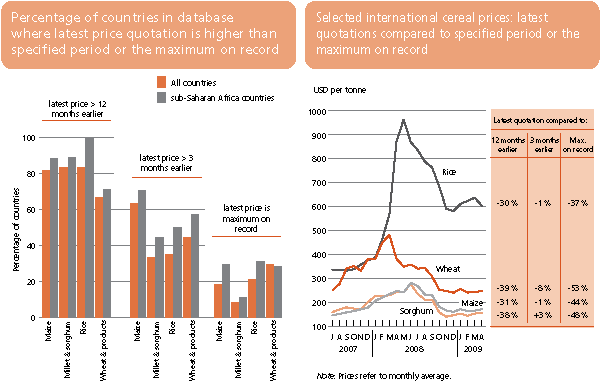No.2  April 2009 April 2009 | ||
 |
Crop Prospects and Food Situation | |
|
New FAO database confirms that domestic prices in developing countries remain very highFAO GIEWS has recently launched the National basic food price data and analysis tool1 as part of the FAO Initiative on Soaring Food Prices (ISFP) to assist in the monitoring and analysis of domestic food price trends in developing countries. The database covers about 800 monthly domestic retail/wholesale price series of major foods2 consumed in 58 developing countries, and international cereal export prices. An initial analysis (April 2009) of the data contained in the database confirms earlier reports that domestic prices in developing countries remain generally very high and in some cases are record high. Out of the 790 domestic price quotations (nominal, in local currencies) for all food commodities included in the database, the most recent quotation3 is higher than 12 months earlier in 78 percent of the cases and higher than 3 months earlier in 43 percent of the cases. In 17 percent of the cases, latest price quotations are the highest on record. This is in sharp contrast with developments in international food markets, where prices of most commodities have fallen sharply since their peaks of the first-half of 2008. For cereals, the most important staple food in developing countries, the situation is quite similar with latest nominal domestic price quotations considerably higher than 12 months earlier in about 80 percent of the countries covered in the database and higher than 3 months earlier in 35 to 65 percent of the countries, depending on the type of cereal. In 10 to 30 percent of the countries, latest food prices available in GIEWS by late March were the highest on record. The situation is even more dramatic in Sub-Saharan Africa. Domestic prices of rice are much higher than 12 months earlier in 100 percent of the countries covered in the database, while prices of maize, millet and sorghum are higher than 12 months earlier in about 89 percent of the countries. For wheat and wheat products, 71 percent of the countries surveyed show prices higher than 12 months earlier. With the exception of millet, latest prices of other cereals were much higher than reached during the crises in 2008 in about a third of the countries, mostly in Eastern and Southern Africa. However, food prices remain at high levels also in other regions, particularly in Asia for rice and in Central and South America for maize and wheat. In contrast with trends in domestic food prices, international cereal export prices are considerably lower than in 2008. Maize, sorghum, wheat and rice export prices are respectively 31 percent, 38 percent, 39 percent and 30 percent lower than 12 months earlier and between 37 and 53 percent below their 2008 peaks. 
1. The “National basic food price – data and analysis tool” is available on the FAO Website at: www.fao.org/giews/pricetool 2. Mainly cereals and cereal products but also beans, potatoes and cassava and some animal products 3. The most recent price quotation refers, with few exceptions, to the period between January and April 2009 |
| GIEWS | global information and early warning system on food and agriculture |